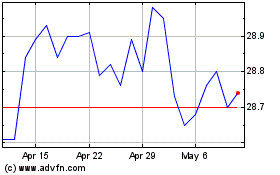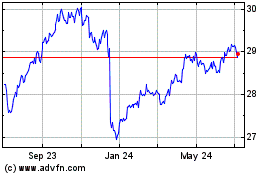Australian Dollar ETF Falls on Rate Cut - ETF News And Commentary
May 08 2013 - 6:07AM
Zacks
In Australia, investors have seen tame inflation, lower credit
demand, and soft economic growth over the past few months. Still,
the Australian dollar has remained firm, hurting exports across the
board.
If that wasn’t enough we also saw weaker retail sales in the
country along with brewing concerns over a housing bubble in the
nation. In an attempt to alleviate the economy from these worries,
the Reserve Bank of Australia slashed interest rates by 25 bps to a
record low of 2.75%.
This is the first time that the interest rates have breached the
3% level in the country, and it comes as somewhat of a surprise as
most were expecting no change from the central bank. As a result
the rate cut has pushed down the Aussie dollar, as represented by
the CurrencyShares Australian Dollar Trust ETF
(FXA) by roughly 0.7% (read: What's Next for Currency
ETFs?).
Aussie Economy Outlook
Australia has enjoyed more than 20 years of continuous growth,
though at a slower pace in recent years. The economy maintains a
favorable balance of trade, strong per capita income (one of the
highest in the world), low unemployment, low budget deficit and
high levels of economic freedom.
The country has always been a commodity powerhouse and major
exporter of commodities – base metals, coal and agricultural
products. As a result, the falling commodity prices have gone a
long way in hurting the Australian economy.
Also, adding to its woes is the generic slowdown and continuous
decrease in industrial production in the world’s second largest
economy and one of its largest trading partners — China.
Further, the country has been deeply lacking in one area, which
is oil. However, a recent massive shale oil discovery could
dramatically alter this scenario going forward (read: Australia
ETFs to Play the Coming Shale Boom).
Australian Dollar ETF in Focus
The Australian Dollar ETF tracks the relative movement of the
AUD relative to the USD. The funds in this product are denominated
in AUD and kept in a bank account, and the interest thus received
is used to pay for the expenses and fees of the fund.
The fund looks to generate returns through the bank interest and
any capital appreciation that may occur on account of AUD
appreciating versus the USD.
The ETF has amassed $551.6 million in its asset base since its
introduction in June 2006 and yields a decent 1.71% in annual
dividends. FXA has lost 1.56% in the year-to-date time frame
though, with more short-term losses possibly after the slide (read:
Time to Buy the Australian Dollar ETF?).

Still, we believe the longer term outlook is relatively bright
for this ETF as we currently have a Zacks ETF Rank of 2 or ‘Buy’ on
FXA going forward. The product remains one of the best options for
investing in the space, charging just 40 bps in fees and possessing
a relatively high average trading volume as well.
So for investors who believe in the Aussie economy’s resilience
now might be an interesting time to consider FXA. The product has
been beaten down over the past few weeks, but it could rise back up
soon as carry trade investors seek the haven that is the Aussie
dollar, especially when compared to the yen.
Want the latest recommendations from Zacks Investment Research?
Today, you can download 7 Best Stocks for the Next 30
Days. Click to get this free report >>
CRYSHS-AUS DOLR (FXA): ETF Research Reports
PWRSH-DB US$ BU (UUP): ETF Research Reports
To read this article on Zacks.com click here.
Zacks Investment Research
Want the latest recommendations from Zacks Investment Research?
Today, you can download 7 Best Stocks for the Next 30 Days. Click
to get this free report
Invesco DB US Dollar Ind... (AMEX:UUP)
Historical Stock Chart
From Mar 2024 to Apr 2024

Invesco DB US Dollar Ind... (AMEX:UUP)
Historical Stock Chart
From Apr 2023 to Apr 2024
